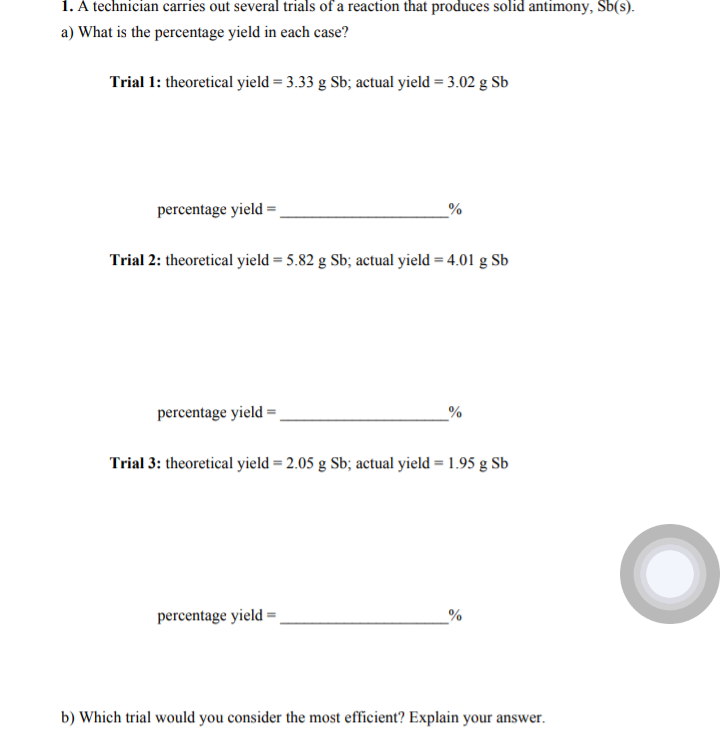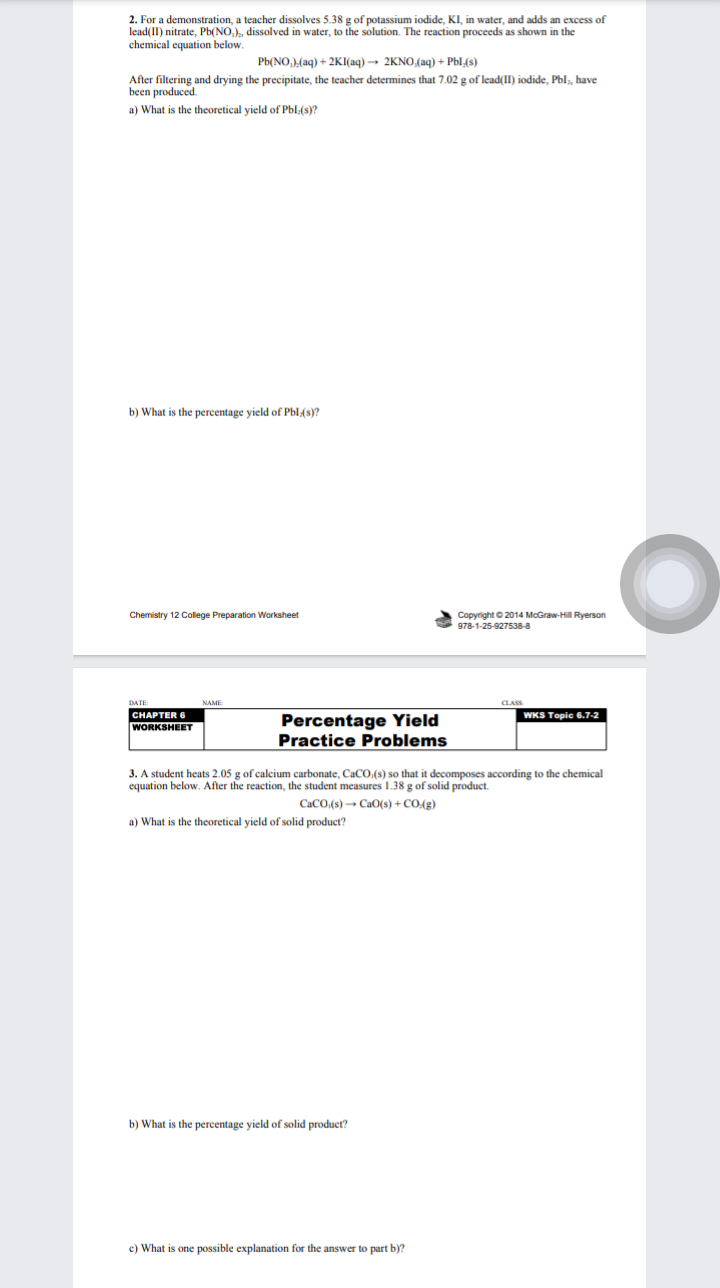1. A technician carries out several trials of a reaction that produces solid antimony, Sb(s). a) What is the percentage yield in each case? Trial 1: theoretical yield = 3.33 g Sb; actual yield = 3.02 g Sb percentage yield = Trial 2: theoretical yield = 5.82 g Sb; actual yield = 4.01 g Sb percentage yield = _% Trial 3: theoretical yield = 2.05 g Sb; actual yield = 1.95 g Sb percentage yield = b) Which trial would you consider the most efficient? Explain your answer.
1. A technician carries out several trials of a reaction that produces solid antimony, Sb(s). a) What is the percentage yield in each case? Trial 1: theoretical yield = 3.33 g Sb; actual yield = 3.02 g Sb percentage yield = Trial 2: theoretical yield = 5.82 g Sb; actual yield = 4.01 g Sb percentage yield = _% Trial 3: theoretical yield = 2.05 g Sb; actual yield = 1.95 g Sb percentage yield = b) Which trial would you consider the most efficient? Explain your answer.
Chapter3: Stoichiometry
Section: Chapter Questions
Problem 172CP: The aspirin substitute, acetaminophen (C8H9O2N), is produced by the following three-step synthesis:...
Related questions
Question

Transcribed Image Text:1. A technician carries out several trials of a reaction that produces solid antimony, Sb(s).
a) What is the percentage yield in each case?
Trial 1: theoretical yield = 3.33 g Sb; actual yield = 3.02 g Sb
percentage yield =
Trial 2: theoretical yield = 5.82 g Sb; actual yield = 4.01 g Sb
percentage yield =
_%
Trial 3: theoretical yield = 2.05 g Sb; actual yield = 1.95 g Sb
percentage yield =
b) Which trial would you consider the most efficient? Explain your answer.

Transcribed Image Text:2. For a demonstration, a teacher dissolves 5.38 g of potassium iodide, KI, in water, and adds an excess of
lead(II) nitrate, Pb(NO,), dissolved in water, to the solution. The reaction proceeds as shown in the
chemical equation below.
Pb(NO,),(aq) + 2KI(aq) → 2KNO,(aq) + Pbl.(s)
After filtering and drying the precipitate, the teacher determines that 7.02 g of lead(II) iodide, Pbls, have
been produced.
a) What is the theoretical yield of Pbl:(s)?
b) What is the percentage yield of Pbl:(s)?
Copyright © 2014 McGraw-Hil Ryerson
978-1-25-927538-8
Chemistry 12 College Preparation Worksheet
DATE
CLASS
CHAPTER 6
WKS Topic 6.7-2
Percentage Yield
Practice Problems
WORKSHEET
3. A student heats 2.05 g of calcium carbonate, CaCO.(s) so that it decomposes according to the chemical
equation below. After the reaction, the student measures 1.38 g of solid product.
CaCO.(s) → CaO(s) + CO:(g)
a) What is the theoretical yield of solid product?
b) What is the percentage yield of solid product?
c) What is one possible explanation for the answer to part b)?
Expert Solution
This question has been solved!
Explore an expertly crafted, step-by-step solution for a thorough understanding of key concepts.
This is a popular solution!
Trending now
This is a popular solution!
Step by step
Solved in 2 steps

Knowledge Booster
Learn more about
Need a deep-dive on the concept behind this application? Look no further. Learn more about this topic, chemistry and related others by exploring similar questions and additional content below.Recommended textbooks for you


Chemistry
Chemistry
ISBN:
9781305957404
Author:
Steven S. Zumdahl, Susan A. Zumdahl, Donald J. DeCoste
Publisher:
Cengage Learning

Introductory Chemistry: A Foundation
Chemistry
ISBN:
9781337399425
Author:
Steven S. Zumdahl, Donald J. DeCoste
Publisher:
Cengage Learning


Chemistry
Chemistry
ISBN:
9781305957404
Author:
Steven S. Zumdahl, Susan A. Zumdahl, Donald J. DeCoste
Publisher:
Cengage Learning

Introductory Chemistry: A Foundation
Chemistry
ISBN:
9781337399425
Author:
Steven S. Zumdahl, Donald J. DeCoste
Publisher:
Cengage Learning

Chemistry by OpenStax (2015-05-04)
Chemistry
ISBN:
9781938168390
Author:
Klaus Theopold, Richard H Langley, Paul Flowers, William R. Robinson, Mark Blaser
Publisher:
OpenStax

Chemistry: An Atoms First Approach
Chemistry
ISBN:
9781305079243
Author:
Steven S. Zumdahl, Susan A. Zumdahl
Publisher:
Cengage Learning

Introductory Chemistry: A Foundation
Chemistry
ISBN:
9781285199030
Author:
Steven S. Zumdahl, Donald J. DeCoste
Publisher:
Cengage Learning